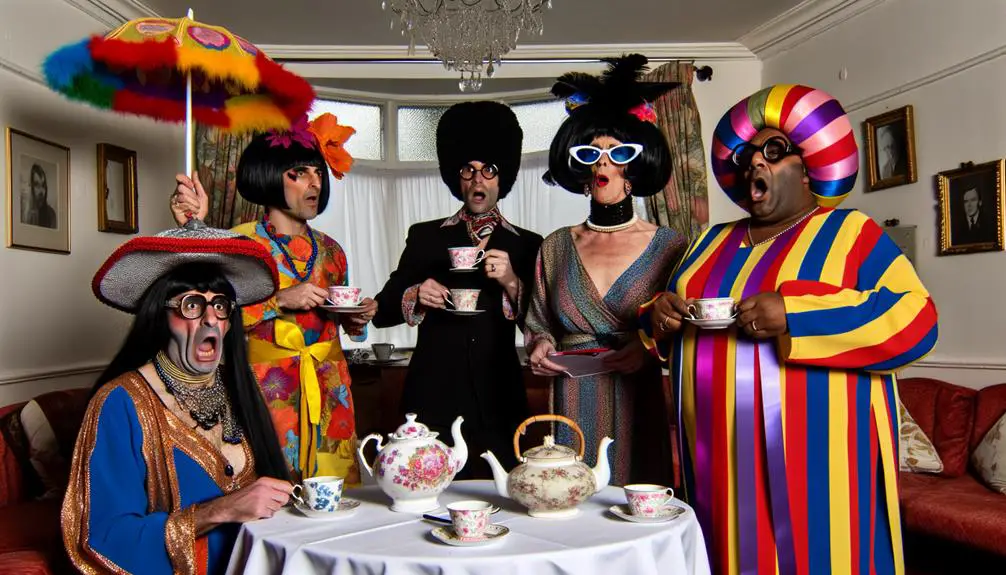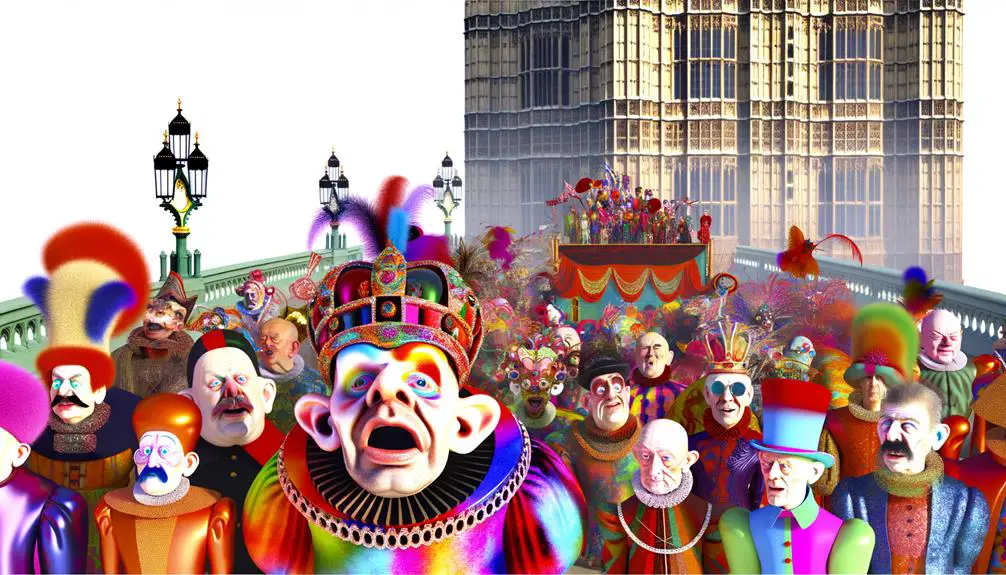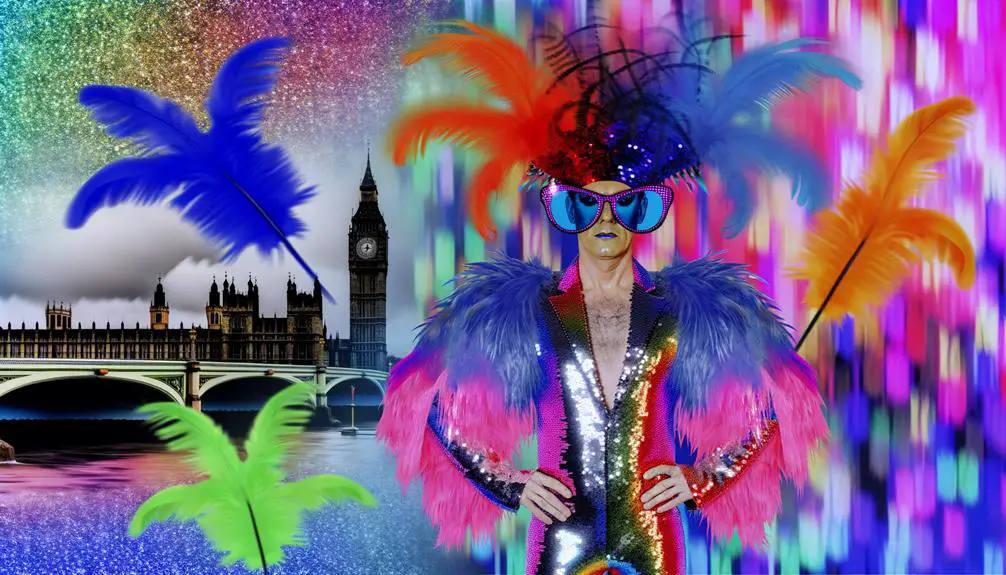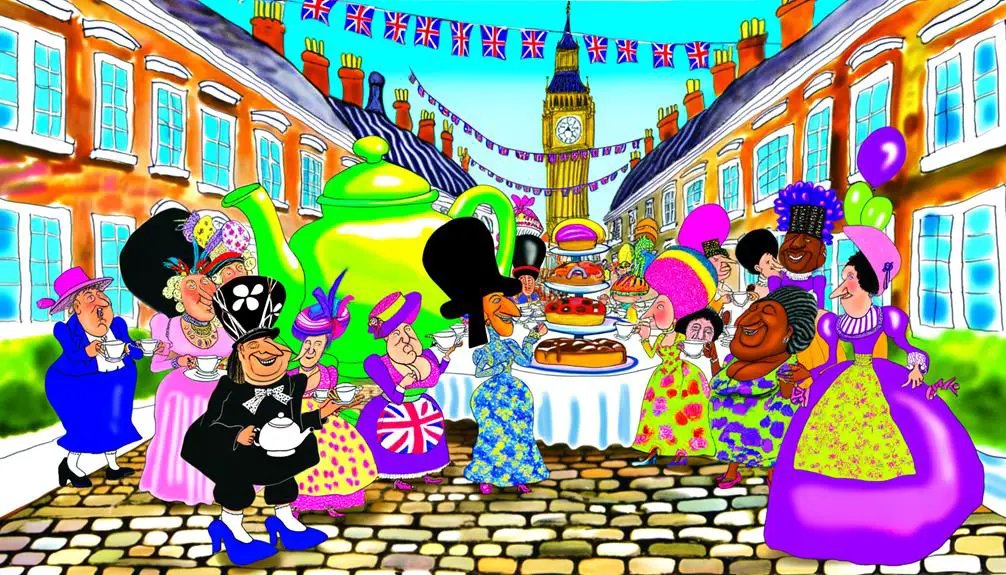In British slang, "campy" epitomizes a unique blend of irony, theatrical extravagance, and satire. It's rooted in a 19th-century vernacular, evolving from exaggerated theatricality to a sophisticated form of cultural critique. Campiness challenges conventional aesthetics and norms through its dramatic flair and irony, offering a deliberate commentary on societal expectations. This term doesn't just describe over-the-top fashion or style; it's a nuanced expression that navigates between traditional and modern sensibilities, critiquing authenticity and aesthetics. By appreciating campy's complexities, you uncover a deeper understanding of its role in expressing cultural identities and commentary, revealing layers of meaning beyond its surface flamboyance.
Key Takeaways
- Campy in British slang denotes exaggerated theatricality and ostentatious behavior.
- It embodies irony, exaggeration, and theatricality, often as a form of social critique.
- Campiness challenges conventional aesthetics and norms with its dramatic flair.
- The concept has roots in 19th-century British slang, linked to the French term 'se camper'.
- It serves as a nuanced expression navigating between traditional and modern sensibilities in British culture.
Origins of 'Campy'

Exploring the origins of 'campy' reveals its roots in 19th-century British slang, where it initially denoted exaggerated theatricality and ostentatious behavior. This linguistic journey into the term's past is not without its etymology debate, as scholars dissect various linguistic variations that have contributed to its current meaning. The term 'campy', with its flamboyant connotations, reflects a complex interplay of language and social dynamics over time.
Delving deeper, the etymology debate surrounding 'campy' is rich with theories. Some linguists argue that its origins are linked to the French term 'se camper', meaning to pose in an exaggerated fashion, which underscores the performative aspect inherent in the term. This connection points to a transnational influence on British slang, highlighting the fluidity of language across cultural boundaries.
Furthermore, linguistic variations of 'campy' have surfaced throughout different periods, each iteration adding layers of meaning and nuance. These variations testify to the evolving nature of language in reflecting societal attitudes towards extravagance and performance. As you examine these linguistic shifts, it becomes evident that 'campy' is more than a mere word; it is a cultural artifact that encapsulates the playful, often subversive, embrace of theatricality in everyday life.
Campy in British Culture
In British culture, 'campy' has evolved to embody a unique blend of irony, exaggeration, and theatricality, reflecting the nation's complex relationship with performance and identity. This term, deeply ingrained in the social fabric, signifies more than mere humor or performance style; it represents a nuanced form of expression that navigates the boundaries of traditional and modern sensibilities. Campy humor, characterized by its witty, often absurd nature, serves as a vehicle for critique and commentary, offering a mirror to societal norms and expectations through a lens of satirical exaggeration. It's a tribute to the British penchant for understatement and overstatement, simultaneously embracing and poking fun at the very essence of what it means to perform one's identity.
Similarly, campy performances in British culture are not merely about flamboyance or ostentation but are imbued with a deeper significance. They challenge and subvert conventional notions of authenticity, artifice, and aesthetics, engaging audiences in a complex dialogue about the nature of reality and representation. Through these performances, the concept of 'campy' transcends its superficial associations, becoming a sophisticated commentary on the performative aspects of daily life, and highlighting the fluidity and constructedness of cultural identities.
Characteristics of Campiness

Often, campiness manifests through an intentional overemphasis on style and theatricality, challenging conventional aesthetics with its distinct flair for the dramatic. This penchant for theatrical exaggeration not only serves as a form of expression but also as a critique, subverting traditional norms and highlighting the absurdity within them. Campy humor, with its roots deeply embedded in this aesthetic, leverages irony and satire, employing an extravagant style that might seem ludicrous or exaggerated to the uninitiated. Yet, it's this very exaggeration that encapsulates the essence of campiness, offering a unique lens through which the world can be reinterpreted and experienced anew.
The characteristics of campiness extend beyond mere aesthetic choices, embedding themselves in the narrative structure and the portrayal of characters. These elements are imbued with a sense of irony and parody, often engaging with themes and motifs in a manner that is both self-aware and critical. Theatrical exaggeration, as a hallmark of campiness, is not merely for show; it is a deliberate strategy employed to comment on, and sometimes subvert, societal norms and expectations. Through its distinct approach to humor and critique, campiness invites you to question the ordinary, pushing the boundaries of conventional taste and embracing the unconventional with open arms.
Famous Campy Figures
You'll find that iconic campy celebrities serve as quintessential examples of campiness in action, embodying its essence through their performances and public personas. Their flamboyant and exaggerated styles are not merely superficial; they hold a mirror to the complexities and nuances of camp as a concept. Analyzing these figures and their hallmark characteristics offers a concrete understanding of campy style's impact on culture and expression.
Iconic Campy Celebrities
Several iconic celebrities have epitomized the essence of 'campy,' embodying its extravagant, theatrical flair with remarkable prowess. Their performances and public personas often ignite a spectrum of celebrity reactions, ranging from admiration to perplexity, underscoring the diverse appeal of camp aesthetics. These figures not only captivate local audiences but also command global interpretations of camp, illustrating its fluidity across cultural boundaries. Through their work, campy celebrities serve as conduits for exploring the nuances of humor, parody, and social commentary, thereby enriching the discourse on what constitutes 'camp.' Their legacy, marked by an indelible impact on the arts and popular culture, invites scholarly examination of camp's evolving role in challenging conventional norms and celebrating uniqueness.
Campy Style Hallmarks
Campy style, epitomized by certain iconic figures, is characterized by its exaggerated, theatrical qualities that challenge traditional aesthetics and norms. At its core, this style thrives on the deliberate use of over-the-top elements to provoke thought and subvert expectations. It's where modern interpretations collide with theatrical influences, creating a vibrant tapestry that spans various forms of media and expression. The hallmark of campy style lies in its ability to blend irony with earnestness, thereby crafting a unique space where absurdity and sincerity coexist. This intricate balance necessitates a deep understanding of both historical contexts and contemporary culture, allowing for a nuanced approach to campiness that transcends mere parody. Through this lens, campy figures become emblematic of a broader commentary on societal conventions, inviting viewers to reconsider their perceptions of art, fashion, and performance.
Campy Fashion and Style

In examining campy fashion and style, you'll find that iconic camp outfits serve as a pivotal reference point in understanding the genre's aesthetic. These ensembles not only encapsulate the essence of camp but also highlight its evolution over time. By analyzing the progression of camp aesthetics, you'll gain insight into the broader cultural and societal shifts that influence this unique style.
Iconic Camp Outfits
Exploring iconic camp outfits reveals a rich tapestry of fashion that challenges traditional aesthetics through exaggeration and theatricality. Drag queens and Pride parades have been instrumental in popularizing camp fashion, showcasing ensembles that defy conventional norms with flamboyant colors, extravagant fabrics, and bold patterns. These outfits are not simply about garnering attention; they serve as a form of social commentary, critiquing and playing with ideas of gender, identity, and culture. The essence of camp fashion lies in its ability to subvert expectations, merging humor with critique in a visually striking manner. By embracing the outrageous and the over-the-top, camp outfits offer a unique lens through which to explore the complexities and fluidities of identity, challenging observers to reconsider their perceptions of normalcy and taste.
Camp Aesthetics Evolution
Over the years, camp aesthetics have undergone significant transformations, reflecting broader social, cultural, and political shifts. Modern interpretations of campy fashion and style accentuate its malleable nature, allowing it to adapt and resonate across different eras and communities. The global spread of camp aesthetics has facilitated a rich dialogue between various cultural perspectives, enriching its expression and understanding.
- Exaggeration and Irony: Central to camp's evolution, these elements challenge traditional notions of taste and beauty.
- Political Subtext: Camp often carries a subversive undercurrent, critiquing societal norms and structures.
- Inclusivity and Diversity: The embracing of varied identities and expressions has expanded camp's relevance and appeal.
Analyzing camp's trajectory reveals its dynamic capacity to mirror and question the complexities of the contemporary world.
Campys Influence on Media
Campy's distinct influence on media has reshaped how audiences perceive humor, drama, and aesthetic in television and film, merging high art with low culture in a unique blend that challenges traditional narratives. This transformation is conspicuously visible in how campy criticism and global interpretations interplay, creating a dynamic discourse within media studies. Camp, with its inherent irony and exaggeration, invites viewers to question the seriousness of the content, while simultaneously enjoying its over-the-top nature.
The aesthetic's border-crossing appeal has led to a varied reception, where what might be considered camp in one culture could be interpreted differently in another, thereby enriching the global media landscape. This dichotomy between critical reception and popular enjoyment underscores camp's complex position within cultural analysis.
| Aspect of Influence | Emotional Impact |
|---|---|
| Challenge to Norms | Liberation, Joy |
| Aesthetic Blending | Nostalgia, Surprise |
| Global Interpretations | Curiosity, Unity |
These elements highlight the multifaceted impact of campy media, both as a form of entertainment and as a subject for scholarly examination. Its ability to evoke such a broad spectrum of emotions underpins its enduring allure and significance in shaping contemporary media narratives.







